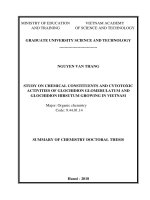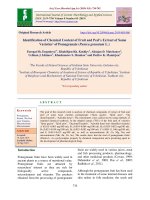Chemical constituents from methanolic extract of Solanum procumbens Lour (Solanaceae)
Bạn đang xem bản rút gọn của tài liệu. Xem và tải ngay bản đầy đủ của tài liệu tại đây (601.07 KB, 3 trang )
��������������������������������������������������������������������������������������������������������������������������������������������������������������������������������������������������������������������������������������������������������������������������������������������������������������������������������������������������������������������������������������������������������������������������������������������������������������������������������������������������������������������������������������������������������������������������������������������������������������������������������������������������������������������������������������������������������������������������������������������������������������������������������������������������������������������������������������������������������������������������������������������������������������������������������������������������������������������������������������������������������������������������������������������������������������������������������������������������������������������������������������������������������������������������������������������������������������������������������������������������������������������������������������������������������������������������������������������������������������������������������������������������������������������������������������������������������������������������������������������������������������������������������������������������������������������������������������������������������������������������������������������������������������������������������������������������������������������������������������������������������������������������������������������������������������������������������������������������������������������������������������������������������������������������������������������������������������������������������������������������������������������������������������������������������������������������������������������������������������������������������������������������������������������������������������������������������������������������������������������������������������������������������������������������������������������������������������������������������������������������������������������������������������������������������������������������������������������������������������������������������������������������������������������������������������������������������������������������������������������������������������������������������������������������������������������������������������������������������������������������������������������������������������������������������������������������������������������������������������������������������������������������������������������������������������������������������������������������������������������������������������������������������������������������������������������������������������������������������������������������������������������������������������������������������������������������������������������������������������������������������������������������������������������������������������������������������������������������������������������������������������������������������������������������������������������������������������������������������������������������������������������������������������������������������������������������������������������������������������������������������������������������������������������������������������������������������������������������������������������������������������������������������������������������������������������������������������������������������������������������������������������������������������������������������������������������������������������������������������������������������������������������������������������������������������������������������������������������������������������������������������������������������������������������������������������������������������������������������������������������������������������������������������������������������������������������������������������������������������������������������������������������������������������������������������������������������������������������������������������������������������������������������������������������������������������������������������������������������������������������������������������������������������������������������������������������������������������������������������������������������������������������������������������������������������������������������������������������������������������������������������������������������������������������������������������������������������������������������������������������������������������������������������������������������������������������������������������������������������������������������������������������������������������������������������������������������������������������������������������������������������������������������������������������������������������������������������������������������������������������������������������������������������������������������������������������������������������������������������������������������������������������������������������������������������������������������������������������������������������������������������������������������������������������������������������������������������������������������������������������������������������������������������������������������������������������������������������������������������������������������������������������������������������������������������������������������������������������������������������������������������������������������������������������������������������������������������������������������������������������������������������������������������������������������������������������������������������������������������������������������������������������������������������������������������������������������������������������������������������������������������������������������������������������������������������������������������������������������������������������������������������������������������������������������������������������������������������������������������������������������������������������������������������������������������������������������������������������������������������������������������������������������������������������������������������������������������������������������������������������������������������������������������������������������������������������������������������������������������������������������������������������������������������������������������������������������������������������������������������������������������������������������������������������������������������������������������������������������������������������������������������������������������������������������������������������������������������������������������������������������������������������������������������������������������������������������������������������������������������������������������������������������������������������������������������������������������������������������������������������������������������������������������������������������������������������������������������������������������������������������������������������������������������������������������������������������������������������������������������������������������������������������������������������������������������������������������������������������������������������������������������������������������������������������������������������������������������������������������������������������������������������������������������������������������������������������������������������������������������������������������������������������������������������������������������������������������������������������������������������������������������������������������������������������������������������������������������������������������������������������������������������������6), 148.6 (C-7), 140.3 (C-3), 131.2
(C-3’), 130.5 (C-5’, -7’), 128.4 C-4), 122.6 (C-9), 120.1
(C-2), 116.1 (C-8, -4’, -8’), 111.3 (C-5), 56.3 (-OCH3),
41.9 (C-1’), 35.8 (C-2’). HRESIMS m/z 336.1207 [M+Na]+
(calcd for C18H19NO4Na, 336.1212).
September 2019 • Vol.61 Number 3
Physical sciences | Chemistry
28
21
18
HO
O
H
O
O
5'
3''
(3)
28
27
H
3
3'
NH
O
(1)
19
L-phenylalanyl)-L-phenylalanol [5], the structure of 3 was
concluded as illustrated.
OH
1
5 HN
1''
26
H
O
3
21
18
HO
27
H
19
1'
O
3
26
(2)
HO 7
O 6
4
H
4'
1 N
O
1'
6' OH
(4)
Fig. 1. The chemical structures of compounds 1-4.
Results and discussion
Compound 1 was isolated as a white solid. The 1H
NMR spectrum exhibited the signals for two cis-olefinic
protons [δH 6.49 (1H, d, J = 8.5 Hz, H-6) and 6.23 (1H,
d, J = 8.5 Hz, H-7)], two trans-olefinic protons [δH
5.28 (1H, dd, J = 7.5, 15.3 Hz, H-23)] and 5.21 (1H, dd,
J = 8.2, 15.3 Hz, H-24)], one oxymethine proton (δH 3.76, H-3),
and six methyl groups (δH 0.84-1.03). The 13C NMR spectrum
illustrated the presence of 28 carbons, including the signals
for four olefinic carbons (δC 130.0-137.0), three oxygenated
carbons (δC 66.5-82.5), six methyl carbons, and other aliphatic
carbons. All above NMR data suggested that the structure of
1 was the ergostan-type steroid. These data closely resembled
those of ergosterol peroxide [2]. Therefore, the structure of 1
was established as indicated.
Compound 2 was isolated as a white solid. The 1H NMR
spectrum displayed the closely similar signals relative to that of
compound 1, aside from the presence of an additional olefinic
signal at δH 5.46 (1H, dd, J = 6.0, 2.0 Hz, H-11). The 13C
NMR spectrum of 2 exhibited 28 resonance signals, including
the presence of two olefinic carbons [δC 116.0 (C-9), 119.5
(C-11)] instead of the C-9 methine and C-11 methylene signals
in 1. These data were also characteristic of the ergostan-type
steroid and closely resembled those of 9.11-dehydroergosterol
peroxide [4]. Therefore, the structure of 2 was concluded.
Compound 3 was isolated as a white solid. The 1H NMR
spectrum of 3 exhibited the signals of 15 aromatic protons
(δH 7.00-7.80 ppm), one methine proton [δH 4.78 (1H, ddd,
J = 8.7, 7.6, 5.9 Hz, H-2)] coupled with one methylene group
[δH 3.26 (1H, dd, J = 13.5, 5.9 Hz, H-3a), 3.05 (1H, dd, J =
13.5, 8.7 Hz, H-3b)], one nitrogenated methine [δH 4.09 (1H,
qt, J = 7.7, 4.1 Hz, H-2’)], one methylene [δH 2.78 (1H, dd,
J = 13.7, 7.5 Hz, H-3’a) and 2.69 (1H, dd, J = 13.7, 7.3 Hz,
H-3’b)], and one hydroxymethyl [δH 3.44 (2H, m, H-1’)]. Its
13
C NMR spectrum indicated the occurrence of 18 aromatic
carbons (δC 125.0-136.9), two carbonyl carbons (δC 170.9 and
167.3), one hydroxymethyl (δC 63.7), two methylene (δC 38.8
and 37.0), and two nitrogenated carbons (δC 55.4 and 53.0). By
comparing these data with those reported for N-(N-benzoyl-
Compound 4 was isolated as a white solid. The 1H NMR
spectrum of 4 exhibited the signals for two trans-olefinic
protons [δH 7.44 (1H, d, J = 15.6 Hz, H-3) and 6.49 (1H,
d, J = 15.6 Hz, H-2)], one methoxy group [δH 3.88 (3H,
s)], and two methylene groups [δH 3.49 (2H, m, H-1’) and
2.75 (2H, t, J = 7.4 Hz, H-2’)]. The signals of one pair of
ortho-coupled protons [δH 7.06 (2H, d, J = 8.5 Hz, H-5’,
-7’) and 6.76 (2H, d, J = 8.5 Hz, H-4’, -8’)] indicated the
presence of 1.4-disubstituted benzene ring. Moreover, three
aromatic protons of the 1,3,4-trisubstituted benzene ring was
indicated [δH 6.83 (1H, d, J = 8.1 Hz, H-8), 7.04 (1H, dd,
J = 8.2, 1.9 Hz, H-9) and 7.16 (1H, d, J = 1.9 Hz, H-5)]. The
13
C NMR spectrum of 4 displayed resonances for one carbonyl
(δC 166.4), 12 aromatic carbons (δC 95.4-167.2), two
trans-olefinic carbons (δC 120.1, 140.3), one methoxy carbon
(δC 56.3), and two methylene carbons (δC 35.8, 41.9). Therefore,
the structure of 4 was determined as moupinamide, based on a
comparison between these NMR data and the literature [6].
Conclusions
From the methanolic extract of Solanum procumbens
(Solanaceae), four compounds were isolated, including
ergosterol peroxide (1), 9.11-dehydroergosterol peroxide
(2), N-(N-benzoyl-L-phenylalanyl)-L-phenylalanol (3), and
moupinamide (4). The structures of isolated compounds
were established based on NMR, MS data, and comparison
with those in the literature. Moreover, all isolated compounds
were first reported from S. procumbens.
The authors declare that there is no conflict of interest
regarding the publication of this article.
REFERENCES
[1] V.C. Vo (1999), Dictionary of Vietnamese Medicinal Plants, Medical
Publishing House, Hanoi, pp.152-153.
[2] S.M. Yu, H.J. Kim, E.R. Woo, H. Park (1994), “Some sesquiterpenoids
and 5α,8α-epidioxysterols from Solanu lyratum”, Arch. Pharm. Res., 17(1),
pp.1-4.
[3] T.T.P. Nguyen (2015), “Research on extraction and determination of
chemical compounds from trunks and roots of Solanum procumbens Lour”,
Proceeding of the 14th International Conference on Miniaturized Systems for
Chemistry and Life Sciences (MicroTAS), pp.128-135.
[4] Y.K. Chen, Y.H. Kuo, B.H. Chiang, J.M. Lo, L.Y. Sheen (2009), “Cytotoxic
activities of 9,11-dehydroergosterol peroxide and ergosterol peroxide from the
fermentation mycellia of Ganoderma lucidum cultivated in the medium containing
leguminous plants on Hep 3B cells”, J. Agric. Food Chem., 57, pp.5713-5719.
[5] B. Xu, Z. Huang, C. Liu, Z. Cai, W. Pan, P. Cao, X. Hao, G. Liang (2009),
“Synthesis and anti-hepatitis B virus activities of Matijing-Su derivatives”,
Bioorg. Med. Chem., 17, pp.3118-3125.
[6] J. Turnock, S. Cowan, A. Watson, B. Bartholomew, C. Bright, Z. Latif,
S.D. Sarker, R.J. Nash (2001), “N-trans-feruloyltyramine from two species of the
Solanaceae”, Biochem. Syst. Ecol., 29, pp.209-211.
September 2019 • Vol.61 Number 3
Vietnam Journal of Science,
Technology and Engineering
11









